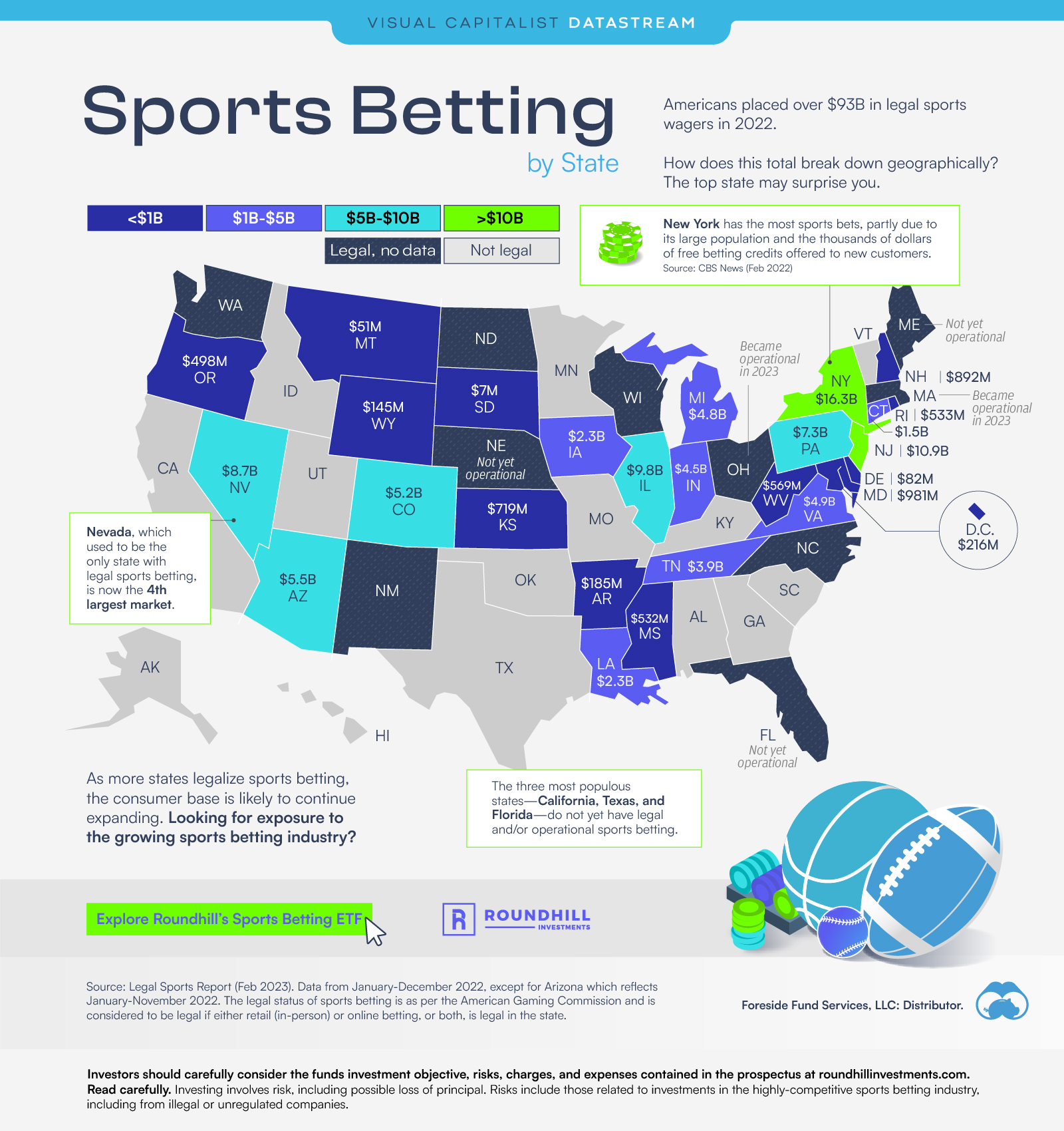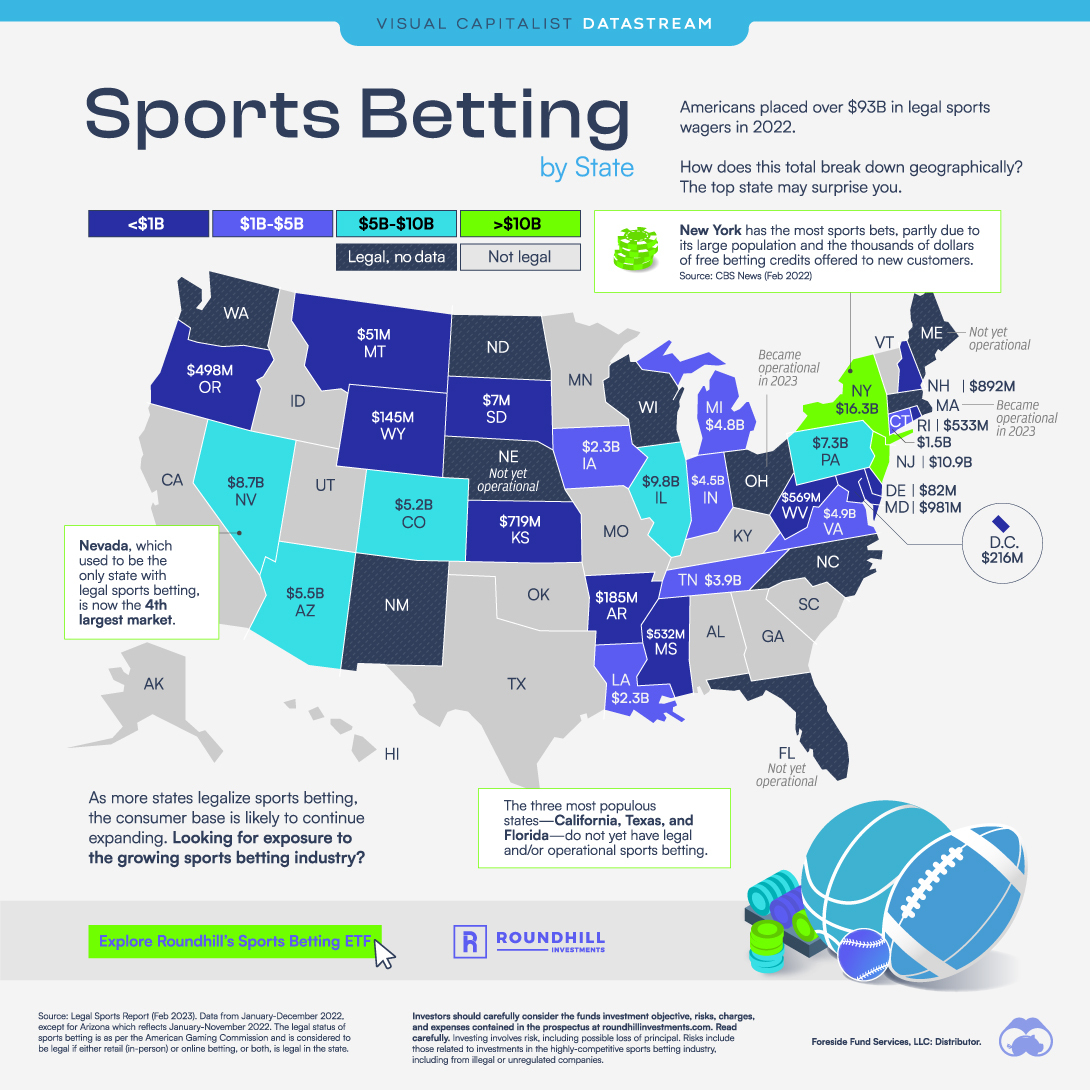Datastream
Mapped: Legal Sports Betting Totals by State
The following content is sponsored by Roundhill Investments.

The Briefing
- Legal sports betting reached over $93 billion in the U.S. in 2022.
- New York State had the most wagers, with a total of $16.3 billion.
Legal Sports Betting Totals by State
Which states are driving the legal sports betting market, and which have not yet become major players? The answer is fueled by each state’s legalization status, population, and other factors.
In this graphic from Roundhill Investments, we show a breakdown of legal sports betting by state.
A State View of Legal Sports Betting
In 2022, sports betting was live in 31 states plus Washington, D.C. Betting activity is highly concentrated, with the top five states accounting for 57% of the total reported legal wagers.
| State/District | Legal Sports Wagers in 2022 |
|---|---|
| New York | $16.3B |
| New Jersey | $10.9B |
| Illinois | $9.8B |
| Nevada | $8.7B |
| Pennsylvania | $7.3B |
| Arizona | $5.5B |
| Colorado | $5.2B |
| Virginia | $4.9B |
| Michigan | $4.8B |
| Indiana | $4.5B |
| Tennessee | $3.9B |
| Iowa | $2.3B |
| Louisiana | $2.3B |
| Connecticut | $1.5B |
| Maryland | $981M |
| New Hampshire | $892M |
| Kansas | $719M |
| West Virginia | $569M |
| Rhode Island | $533M |
| Mississippi | $532M |
| Oregon | $498M |
| Washington D.C. | $216M |
| Arkansas | $185M |
| Wyoming | $145M |
| Delaware | $82M |
| Montana | $51M |
| South Dakota | $7M |
| New Mexico | Legal, no data |
| North Carolina | Legal, no data |
| North Dakota | Legal, no data |
| Washington State | Legal, no data |
| Wisconsin | Legal, no data |
| Massachusetts | Legal, became operational in 2023 |
| Ohio | Legal, became operational in 2023 |
| Florida | Legal, not yet operational |
| Maine | Legal, not yet operational |
| Nebraska | Legal, not yet operational |
| Alabama | Not legal |
| Alaska | Not legal |
| California | Not legal |
| Georgia | Not legal |
| Hawaii | Not legal |
| Idaho | Not legal |
| Kentucky | Not legal |
| Minnesota | Not legal |
| Missouri | Not legal |
| Oklahoma | Not legal |
| South Carolina | Not legal |
| Texas | Not legal |
| Utah | Not legal |
| Vermont | Not legal |
New York State had the most legal sports betting, largely because it was the most populous state to allow online sports wagers so far. Notably, 1.2 million accounts were created in the first 10 days of legalization. New York also has multiple teams across all four major sports—football, basketball, baseball and hockey—which boosts local interest.
New Jersey took the second spot. The state challenged the federal ban against legal sports betting, winning their case in 2018. New Jersey has since rapidly established itself as a sports betting hub, thanks to its established gaming regulations, prime location near New York City and Philadelphia, and strong gaming and tech infrastructure.
Illinois had the third highest annual total, and beat its prior state record with $1 billion in wagers in October alone. One key factor was a change to the registration process in 2022, which allowed residents to sign up online rather than in-person at a casino. Not only that, the state is home to some popular teams including the Chicago Bulls, who have the third-largest social media following of any NBA team.
Smaller, and Not Yet Legal, Markets
South Dakota had the lowest legal sports betting of the states with reported totals. The state only allows in-person betting in the city of Deadwood and at tribal casinos, with the latter not reporting the total bets they receive. Online sports betting is not yet legal in the state unless the bettor is physically at a Deadwood casino.
Montana had the second smallest total bets. The state has a small population and no major league professional sports teams. Not only that, sports betting in the state is government-run rather than a competitive market. Like South Dakota, online bets can only be placed when the bettor is physically present at a retailer.
Notably, the most populous states of California, Texas, and Florida do not yet have legal and/or operational sports betting. Together, the three states represent 27% of the total U.S. population. Sports betting was initially legal in Florida but has been paused due to ongoing legal proceedings.
Expanding Geographic Reach
Legal sports betting has expanded significantly since the federal ban was lifted in 2018. However, 17 states have not yet legalized sports betting in any form, and some states could see growth from allowing online betting.
As more states proceed with legalization, the consumer base is likely to continue expanding. This creates a revenue opportunity for sportsbook operators. In fact, Goldman Sachs estimates that the total revenue opportunity could grow from $900 million in 2021 to $39 billion by 2033.
Looking for exposure to the growing sports betting industry? Explore Roundhill’s sports betting ETF, $BETZ.
Datastream
Can You Calculate Your Daily Carbon Footprint?
Discover how the average person’s carbon footprint impacts the environment and learn how carbon credits can offset your carbon footprint.

The Briefing
- A person’s carbon footprint is substantial, with activities such as food consumption creating as much as 4,500 g of CO₂ emissions daily.
- By purchasing carbon credits from Carbon Streaming Corporation, you can offset your own emissions and fund positive climate action.
Your Everyday Carbon Footprint
While many large businesses and countries have committed to net-zero goals, it is essential to acknowledge that your everyday activities also contribute to global emissions.
In this graphic, sponsored by Carbon Streaming Corporation, we will explore how the choices we make and the products we use have a profound impact on our carbon footprint.
Carbon Emissions by Activity
Here are some of the daily activities and products of the average person and their carbon footprint, according to Clever Carbon.
| Household Activities & Products | CO2 Emissions (g) |
|---|---|
| 💡 Standard Light Bulb (100 watts, four hours) | 172 g |
| 📱 Mobile Phone Use (195 minutes per day)* | 189 g |
| 👕 Washing Machine (0.63 kWh) | 275 g |
| 🔥 Electric Oven (1.56 kWh) | 675 g |
| ♨️ Tumble Dryer (2.5 kWh) | 1,000 g |
| 🧻 Toilet Roll (2 ply) | 1,300 g |
| 🚿 Hot Shower (10 mins) | 2,000 g |
| 🚙 Daily Commute (one hour, by car) | 3,360 g |
| 🍽️ Average Daily Food Consumption (three meals of 600 calories) | 4,500 g |
| *Phone use based on yearly use of 69kg per the source, Reboxed | |
Your choice of transportation plays a crucial role in determining your carbon footprint. For instance, a 15 km daily commute to work on public transport generates an average of 1,464 g of CO₂ emissions. Compared to 3,360 g—twice the volume for a journey the same length by car.
By opting for more sustainable modes of transport, such as cycling, walking, or public transportation, you can significantly reduce your carbon footprint.
Addressing Your Carbon Footprint
One way to compensate for your emissions is by purchasing high-quality carbon credits.
Carbon credits are used to help fund projects that avoid, reduce or remove CO₂ emissions. This includes nature-based solutions such as reforestation and improved forest management, or technology-based solutions such as the production of biochar and carbon capture and storage (CCS).
While carbon credits offer a potential solution for individuals to help reduce global emissions, public awareness remains a significant challenge. A BCG-Patch survey revealed that only 34% of U.S. consumers are familiar with carbon credits, and only 3% have purchased them in the past.
About Carbon Streaming
By financing the creation or expansion of carbon projects, Carbon Streaming Corporation secures the rights to future carbon credits generated by these sustainable projects. You can then purchase these carbon credits to help fund climate solutions around the world and compensate for your own emissions.
Ready to get involved?
>> Learn more about purchasing carbon credits at Carbon Streaming
-

 Technology2 weeks ago
Technology2 weeks agoRanked: The Most Popular Smartphone Brands in the U.S.
-

 Automotive1 week ago
Automotive1 week agoAlmost Every EV Stock is Down After Q1 2024
-

 Money1 week ago
Money1 week agoWhere Does One U.S. Tax Dollar Go?
-

 Green2 weeks ago
Green2 weeks agoRanked: Top Countries by Total Forest Loss Since 2001
-

 Real Estate2 weeks ago
Real Estate2 weeks agoVisualizing America’s Shortage of Affordable Homes
-

 Maps2 weeks ago
Maps2 weeks agoMapped: Average Wages Across Europe
-

 Mining2 weeks ago
Mining2 weeks agoCharted: The Value Gap Between the Gold Price and Gold Miners
-

 Demographics2 weeks ago
Demographics2 weeks agoVisualizing the Size of the Global Senior Population










